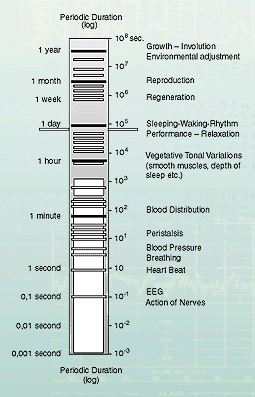Rhythm in normal musical experience, be it for aesthetic enjoyment or with an
educational and therapeutic purpose, assumes there are structures in humans which
follow musical conformities to a natural law.
This is not only true for the immediate receiving organ of hearing, for which e.g. in the form of a snail corresponding laws of formation are known (cf. HAASE 1976), but it must apply to the whole organism; for the whole of a human being participates as a moving organism, as a sensory organism and as an intellectual organism in experiencing music.
Music and musical movement are art forms which are realized in a time area and form time organisms. Of the basic elements of music (melodics, rhythmics, metrics, harmony, agogics, etc.), metrics, rhythmics and agogics are mainly temporal determinations. Melodics and harmony are at first glance more likely to present elements of an aesthetic content, but they also are ultimately based on regulating features determined by time with regard to tonal steps and tonal conditions.
There is therefore sufficient reason to search for biological time structures in humans which can be considered for the musical work and experience as equivalent or reagent – whatever their nature might be. Particularly in view of the educational and therapeutic resources of music, it is likely to be of importance to know in which way and where musical-temporal function orders and structures are realized in the organism.
The results of modern chronobiology and chronomedicine have shown that the human organism does not only have a complicated interior design in terms of space structure, but also has a highly sophisticated time design which is built up from numerous rhythmical time structures.

